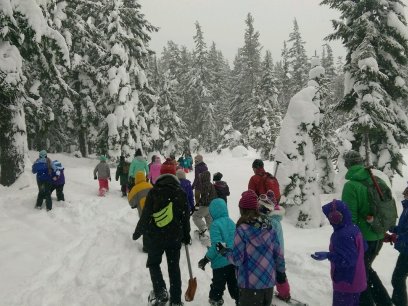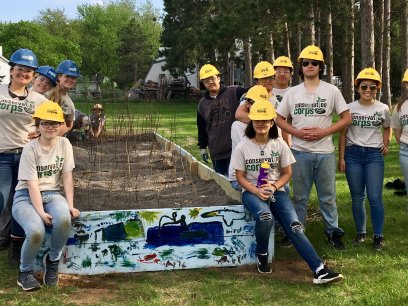
With support from Toyota Motor North America, the National Environmental Education Foundation (NEEF) is pleased to announce $220,000 in grant funding to support biodiversity conservation projects on public lands within the California Floristic Province ecological region.
With an area of approximately 113,438 square miles, the California Floristic Province ecological region includes 70% of California and extends into southwestern Oregon, a small part of western Nevada and northern Baja California. The area was designated a hotspot in 1996 and shares this distinction with 33 other places in the world. Biodiversity hotspots are home to the highest diversity of endemics—plants and animals that are found nowhere else in the world. Part of what makes California a hotspot is that its spectacular biodiversity is seriously threatened with at least 75% of the original habitat already lost.
“Protecting and nurturing these rich ecosystems is vital to supporting all life on our planet,” said Meri-Margaret Deoudes, president and CEO of NEEF. “We appreciate the partnership with Toyota to focus on this important region.”
The grant funds will support a cohort of conservation projects working within the same ecological region to preserve its unique biodiversity. Funds will also be used to engage the public through volunteer and community events designed to educate and address local biodiversity issues in their communities.
"These grants are funding activities that directly address our commitment to achieving the Toyota Environmental Challenge 2050 goals," said Kevin Butt, senior director of environmental sustainability at Toyota North America. "Biodiversity is one of the core focus areas of Toyota North America, and protecting and increasing these unique, rich, but threatened ecosystems, is key to making the world better, safer, and healthier.”
Each of the four projects below was awarded $55,000 towards work that will protect and improve this valuable ecological region.
- Restoring Native Habitat and Saving the Most Endangered Butterfly in North America
(Abalone Cove Habitat Restoration: Palos Verdes Peninsula Land Conservancy, Rolling Hills Estates, California)
Image
The Palos Verdes Peninsula Land Conservancy will restore native habitat at Abalone Cove Ecological Reserve in Rancho Palos Verdes, California. Abalone Cove is one of the most diverse ecosystems in southern California; however, its remaining habitat is a fraction of what it once was due to both widespread development and invasive species spread. Abalone Cove's primary habitat, coastal sage scrub, is 85% degraded or destroyed and is considered one of the most endangered plant communities in the United States.
The purpose of this project is to restore coastal sage scrub, cactus scrub and host plants to support four special status species: the threatened California gnatcatcher, species of special concern cactus wren, and two federally endangered butterflies: El Segundo blue butterfly and Palos Verdes blue butterfly. The Palos Verdes blue butterfly is the most endangered butterfly in North America.
- Protecting the Declining Aspen Population
(Restoring Fringe Meadow Aspen Habitat and Outdoor Education Project in Loney Meadow Complex, South Yuba River Citizens League, Nevada City, California)
The South Yuba River Citizens League (SYRCL) will work to restore and conserve existing aspen stands in the Yuba River watershed as well as protect vulnerable, budding aspen suckers (aspen reproduces both by seeds and by root sprouts, or suckers). The aspen ecosystem is rich in number and species of animals, especially in comparison to associated coniferous forest types. In recent years, scientists have noted that populations of quaking aspen are in decline in the western United States and Canada.
Over the grant period, the SYRCL will install cattle exclusion fencing to protect vulnerable new growth aspen, monitor the health and other possible threats to aspen stands using camera traps and assessment protocols, educate students via the Youth Outdoor Leadership Opportunity (YOLO), and empower community members to responsibly recreate in aspen stands through free educational opportunities and outreach.
- Improving Bio-Rich Grassland Health by Removing Invasive Species
(Green Grass Biodiversity Conservation Initiative at Edgewood County Park and Natural Preserve: San Mateo County Parks and Recreation Foundation, San Mateo, California)
Image
The Edgewood County Park and Natural Preserve in San Mateo County is a biologically-rich preserve home to a mosaic of habitats including grasslands, serpentine outcrops, oak woodlands, and chaparral that support rare, endemic, threatened, and endangered species of plants and butterflies, with an estimated 500 species of plants within just 467 acres.
The Green Grass Biodiversity Conservation Initiative aims to restore Edgewood's non-native grasslands to their former floral beauty and species diversity by reducing or eliminating weeds and promoting greater cover of native plants. Approximately 40% of Edgewood Park consists of grassland, and almost all of Edgewood's grasslands have been significantly degraded due to the invasion of weeds, especially non-native grasses. By employing the best practices of grassland management, including mowing, de-thatching, and selective chemical treatments, the Green Grass Initiative will significantly increase native cover and—since non-native grasses also threaten the Bay checkerspot butterfly, thornmint, and pentachaeta—deliver benefits to at-risk species as well.
This project also supports a multi-year experiment to determine effective methods for controlling non-native grasses and forbs, increasing native cover, and producing long-lasting, healthy, and biodiverse grasslands.
- Reducing Fire Risk and Increasing Plant Diversity in Moro Canyon
(Crystal Cove State Park Native Plant Restoration and Conservation, Crystal Cove Conservancy, Newport Coast, California)
Located in the center of Moro Canyon at the nexus of two major hiking trails, the site known as “the Bowl” has challenged State Park restoration efforts since the 1990s. With a long legacy of disturbance resulting from decades of sheep and cattle grazing, the area has been type-converted over time from biologically diverse coastal sage scrub vegetation and perennial grasslands to biologically poor annual grasslands dominated by invasive black mustard.
Building on established work from the first phase of restoration, which was funded by the State of California, this project will result in the enhancement of 50 acres of coastal sage scrub habitat, resulting in improved ecosystem function and resilience, reduced fire risk, and increased native plant diversity.
Continued Support for Biodiversity Conservation Projects on America's Public Lands
The California Floristic Province ecological region is the second to receive Biodiversity Conservation Grant Funds. In 2019, the National Capital Partnership for Regional Invasive Species Management (PRISM) received funding for a two-year project to manage invasive species across the National Capital Region, restoring biodiversity and protecting critical habitats in parts of Washington, DC, Maryland, and Virginia.
For more information about the funding opportunities from NEEF and its partners, please visit the Grants section of NEEF's website.


